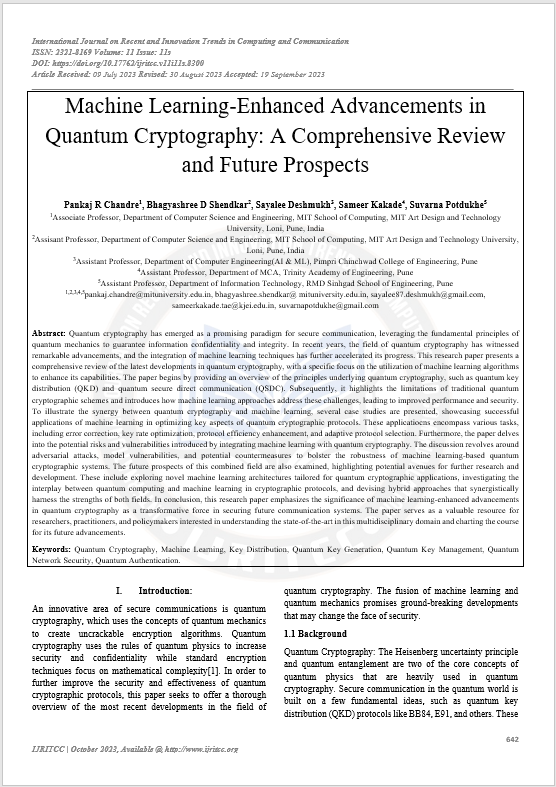Machine Learning-Enhanced Advancements in Quantum Cryptography: A Comprehensive Review and Future Prospects
Main Article Content
Abstract
Quantum cryptography has emerged as a promising paradigm for secure communication, leveraging the fundamental principles of quantum mechanics to guarantee information confidentiality and integrity. In recent years, the field of quantum cryptography has witnessed remarkable advancements, and the integration of machine learning techniques has further accelerated its progress. This research paper presents a comprehensive review of the latest developments in quantum cryptography, with a specific focus on the utilization of machine learning algorithms to enhance its capabilities. The paper begins by providing an overview of the principles underlying quantum cryptography, such as quantum key distribution (QKD) and quantum secure direct communication (QSDC). Subsequently, it highlights the limitations of traditional quantum cryptographic schemes and introduces how machine learning approaches address these challenges, leading to improved performance and security. To illustrate the synergy between quantum cryptography and machine learning, several case studies are presented, showcasing successful applications of machine learning in optimizing key aspects of quantum cryptographic protocols. These applicatiocns encompass various tasks, including error correction, key rate optimization, protocol efficiency enhancement, and adaptive protocol selection. Furthermore, the paper delves into the potential risks and vulnerabilities introduced by integrating machine learning with quantum cryptography. The discussion revolves around adversarial attacks, model vulnerabilities, and potential countermeasures to bolster the robustness of machine learning-based quantum cryptographic systems. The future prospects of this combined field are also examined, highlighting potential avenues for further research and development. These include exploring novel machine learning architectures tailored for quantum cryptographic applications, investigating the interplay between quantum computing and machine learning in cryptographic protocols, and devising hybrid approaches that synergistically harness the strengths of both fields. In conclusion, this research paper emphasizes the significance of machine learning-enhanced advancements in quantum cryptography as a transformative force in securing future communication systems. The paper serves as a valuable resource for researchers, practitioners, and policymakers interested in understanding the state-of-the-art in this multidisciplinary domain and charting the course for its future advancements.
Article Details
References
A. Iqbal, M. Junaid, A. Hafiza, and S. Nayab, “Quantum Cryptography?: A brief review of the recent developments and future perspectives,” no. March, pp. 42–46, 2016.
K. Choudhary et al., “Recent advances and applications of deep learning methods in materials science,” npj Comput. Mater., vol. 8, no. 1, 2022, doi: 10.1038/s41524-022-00734-6.
P. R. Chandre, P. N. Mahalle, and G. R. Shinde, “Machine Learning Based Novel Approach for Intrusion Detection and Prevention System: A Tool Based Verification,” in 2018 IEEE Global Conference on Wireless Computing and Networking (GCWCN), Nov. 2018, pp. 135–140, doi: 10.1109/GCWCN.2018.8668618.
P. R. Chandre, “Intrusion Prevention Framework for WSN using Deep CNN,” vol. 12, no. 6, pp. 3567–3572, 2021.
P. Chandre, P. Mahalle, and G. Shinde, “Intrusion prevention system using convolutional neural network for wireless sensor network,” IAES Int. J. Artif. Intell., vol. 11, no. 2, pp. 504–515, 2022, doi: 10.11591/ijai.v11.i2.pp504-515.
G. R. Pathak and S. H. Patil, “Mathematical Model of Security Framework for Routing Layer Protocol in Wireless Sensor Networks,” Phys. Procedia, vol. 78, no. December 2015, pp. 579–586, 2016, doi: 10.1016/j.procs.2016.02.121.
G. R. Pathak, M. S. G. Premi, and S. H. Patil, “LSSCW: A lightweight security scheme for cluster based Wireless Sensor Network,” Int. J. Adv. Comput. Sci. Appl., vol. 10, no. 10, pp. 448–460, 2019, doi: 10.14569/ijacsa.2019.0101062.
M. Möller and C. Vuik, “On the impact of quantum computing technology on future developments in high-performance scientific computing,” Ethics Inf. Technol., vol. 19, no. 4, pp. 253–269, 2017, doi: 10.1007/s10676-017-9438-0.
F. Valdez and P. Melin, “A review on quantum computing and deep learning algorithms and their applications,” Soft Comput., vol. 4, no. 2019, 2022, doi: 10.1007/s00500-022-07037-4.
C. Ciliberto et al., “Quantum machine learning: A classical perspective,” Proc. R. Soc. A Math. Phys. Eng. Sci., vol. 474, no. 2209, 2018, doi: 10.1098/rspa.2017.0551.
K. Kishor, “computing 12 Review and significance of cryptography and machine learning in quantum computing,” no. August, 2023, doi: 10.1515/9783110798159-012.
A. Zeguendry, Z. Jarir, and M. Quafafou, “Quantum Machine Learning: A Review and Case Studies,” Entropy, vol. 25, no. 2, pp. 1–41, 2023, doi: 10.3390/e25020287.
S. Sun and A. Huang, “A Review of Security Evaluation of Practical Quantum Key Distribution System,” Entropy, vol. 24, no. 2, pp. 1–19, 2022, doi: 10.3390/e24020260.
K. A. Tychola, T. Kalampokas, and G. A. Papakostas, “Quantum Machine Learning—An Overview,” Electron., vol. 12, no. 11, 2023, doi: 10.3390/electronics12112379.
C. W. Tsai, C. W. Yang, J. Lin, Y. C. Chang, and R. S. Chang, “Quantum key distribution networks: Challenges and future research issues in security,” Appl. Sci., vol. 11, no. 9, 2021, doi: 10.3390/app11093767.
S. Pirandola et al., “Advances in quantum cryptography,” Adv. Opt. Photonics, vol. 12, no. 4, p. 1012, 2020, doi: 10.1364/aop.361502.
N. Mishra et al., Quantum Machine Learning: A Review and Current Status, vol. 1175, no. January. Springer Singapore, 2021.
A. Lohachab, A. Lohachab, and A. Jangra, “A comprehensive survey of prominent cryptographic aspects for securing communication in post-quantum IoT networks,” Internet of Things (Netherlands), vol. 9, p. 100174, 2020, doi: 10.1016/j.iot.2020.100174.
K. E. Skouby, I. Williams, and A. Gyamfi, Handbook on ICT in Developing Countries: Next Generation ICT Technologies. 2019.
V. H. Patil, N. Dey, and P. N. Mahalle, “Lecture Notes in Networks and Systems 169 Proceeding of First Doctoral Symposium on Natural Computing Research,” 2020.
S. K. Das, S. Samanta, N. Dey, and R. Kumar, Design Frameworks for Wireless Networks, vol. 82. 2019.

